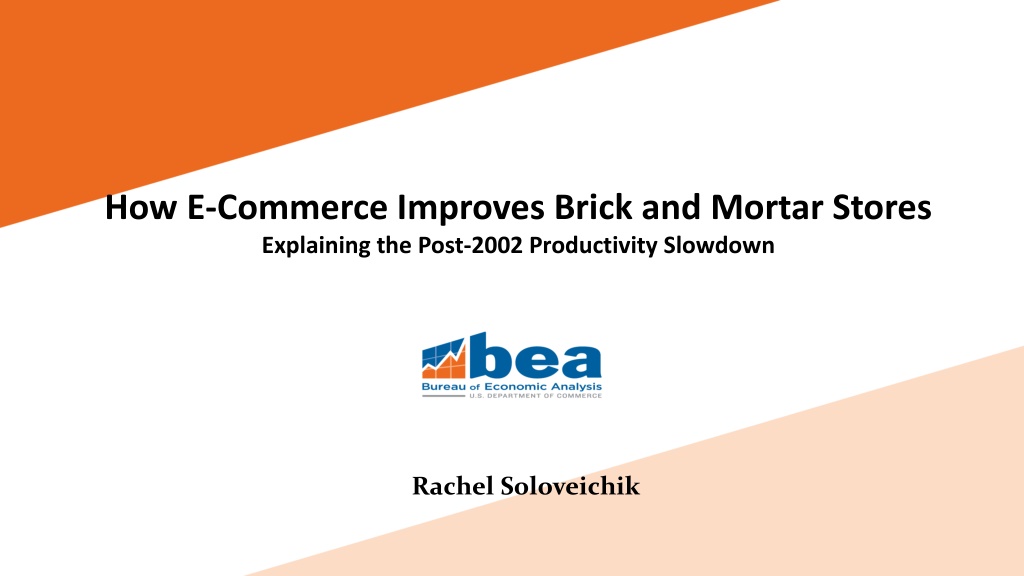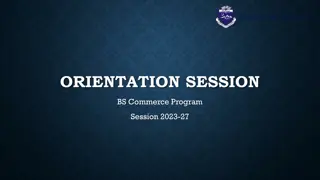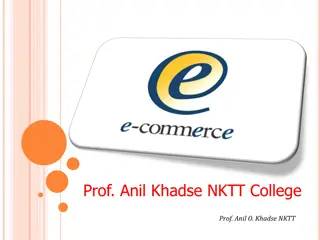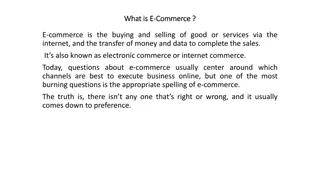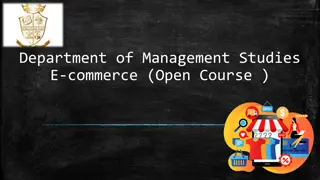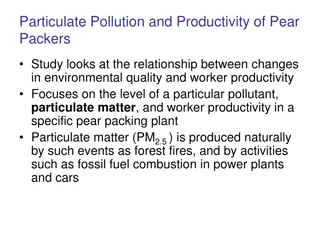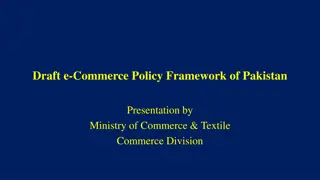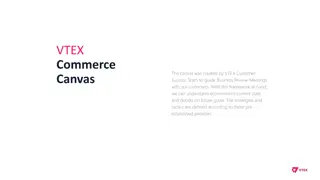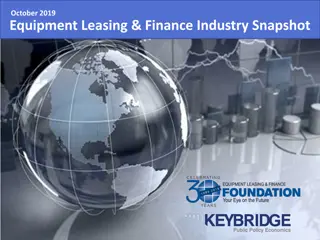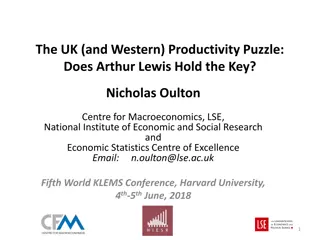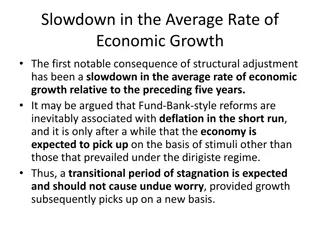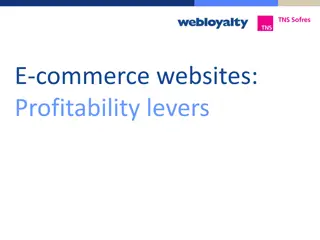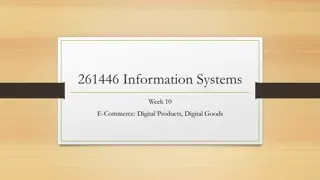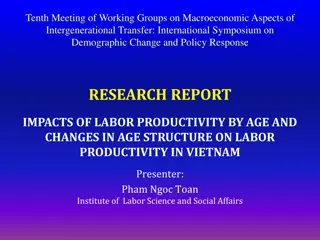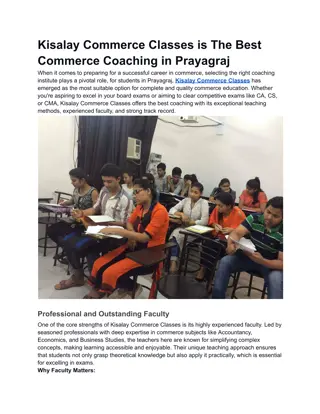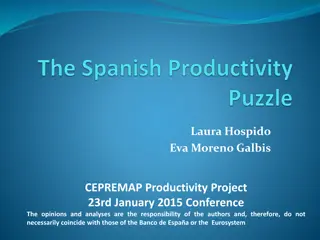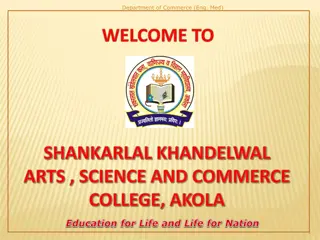Post-2002 Productivity Slowdown and E-Commerce Impact
This study delves into how e-commerce influences brick-and-mortar stores post-2002, shedding light on the productivity slowdown. It explores changes in shopping experiences, methodological shifts, and sales expenses, providing insights into the evolving retail landscape.
Download Presentation

Please find below an Image/Link to download the presentation.
The content on the website is provided AS IS for your information and personal use only. It may not be sold, licensed, or shared on other websites without obtaining consent from the author. Download presentation by click this link. If you encounter any issues during the download, it is possible that the publisher has removed the file from their server.
E N D
Presentation Transcript
How E-Commerce Improves Brick and Mortar Stores Explaining the Post-2002 Productivity Slowdown Rachel Soloveichik
Introduction Free shopping experiences are currently excluded from industry output, final output and GDP. I assume a barter transaction: shoppers give sales attention in return for experiences. Both consumers and businesses shop to get information. Many different types of sellers provide free shopping experiences.
How Have Shopping Experiences Changed? Modern stores have layouts carefully planned to slow shopping, and few staff to help. Older stores had lots of staff to help shoppers find items quickly.
Preview of Talk Verbal $220B Display $264B Tactile $211B Shopping Category Nominal GDP Impact in 2016 2002-2016 Real GDP growth impact percentage points per year 0.01% -0.01% -0.03% 0.01% 0.00% 0.02% 0.04% 0.02% 0.00% 1975-2002 1929-1975 2002-2014 TFP growth impact percentage points per year 0.03% 0.01% -0.05% 0.05% 0.02% -0.04% 0.03% 0.02% -0.00% 1975-2002 1948-1975
Current vs. Experimental Methodology Current Treatment of Free Shopping Experiences: They re not tracked as industry output, industry input or personal consumption. Measured GDP rises when free consumer shopping experiences are replaced by paid consumer shopping experiences. Experimental Treatment of Free Shopping Experiences Just like paid shopping experiences, they re tracked as industry output, industry input or personal consumption. Free experiences are valued based on production cost. Value of sales attention = value of free experiences.
Sales Expenses by Retailers and Wholesalers The Occupational Employment Survey (OES) provides data on earnings by occupation and industry. (Sales Labor Share) = (Earnings for Definitely Sales Workers)/ [(Earnings for Definitely Sales Workers) + (Earnings for Definitely Non-Sales Workers)] The Annual Wholesale and Retail Trade Surveys provide some data on non-sales intermediate expenses. (Sales Share) =(Sales Labor Share)*[1-(Packaging Share)-(Delivery Share) (Sales Commission Share) (Advertising and Marketing Share) (Bad Debt Share)] For other industries, I use sales earnings to impute sales expenses. My sales expense numbers include an imputed return on capital.
Total Sales Expenses Share of Total Nominal GDP
Sales Opportunity Costs Sellers frequently provide free trials to potential customers Generally accepted accounting practice (GAAP) generally does not count lost revenue from unsold or discounted items. I estimate sales opportunity costs for consumer goods: Customer returns which are discounted for resale. Customer shoplifting. Food wastage from customer handling. I impute sales opportunity costs for business goods, consumer services and business services.
Total Sales Opportunity Costs Share of Total Nominal GDP
Valuing Free Consumer Experiences I use BEA s pre-existing I-O tables to allocate shopping between consumers, government and businesses. For the wholesale and retail sector, I used the Economic Census to get more detailed industry data than the published I-O tables. I allocate sales expenses and sales opportunity costs similarly. Free experiences benefit the ultimate user of a good. Wholesalers stock retail shelves, set up promotional displays, etc. I allocate free experiences provided to paid experts (doctors, investment brokers, etc.) to their client s industry. I value free experiences at 50% of total sales output.
Value of Free Consumer Experiences Share of Total Nominal GDP
Prices for Display and Verbal Shopping Ratio of Free Experience Prices to Overall GDP Prices, 2009 Base Year My verbal price index is based on sales labor costs and space rental costs. My display price index is based on sign manufacturing PPI s and space rental costs. My tactile price index is based on the cost of the free goods and services.
Changes to Real GDP from Free Experiences (Change to Quantity Index from Free Experiences)/ (Overall Quantity Index) The pre-1995 and post-1995 trends are both robust. However, the short-term fluctuations are partially due to my imputation methods.
Tracking Sales Attention Over Time Input prices needed to calculate total factor productivity (TFP) TFP Impact = (Attention Input Price)/( Free Experience Output Price) Attention Pricet = (Sales Outputt)/(Attention Quantityt) The American Time Use Survey (ATUS) provides my main dataset. The ATUS has been providing high quality time diary data since 2003. Online shopping experiences are part of free digital content, so I focus on the ATUS s reported location rather than reported activity. The historical time diary data is much spottier, but I located samples from 1939, 1954, 1965, 1975, 1985 and 1993.
Prices for Sales Attention Over Time (Hourly Earnings for Sales Attention)/(Mean Employee Wage)
Constructing Industry-Level Production Accounts CurrentMethodology Experimental Methodology Business Experiences ---- 0 Attention Value-Added 800 200 ---- B 0 C 0 V ---- ---- Business Experiences 50 0 Attention Value-Added 800 200 150 B 0 C 0 V ---- ---- 100 100 ---- Output by Type 800 200 ---- ---- ---- ---- Output by Type 800 200 ---- Primary Free Exp. 100 100 ---- Attention Primary Free Exp. ---- ---- ---- Attention 50 0 150 ------ ---- ---- New output and input by industry: free experiences and attention
Free Experiences Reduce the TFP Slowdown (Change in TFP Index)/(Overall TFP Index), 2009 Base Year
Conclusion Overall GDP Percent points per year (ppy) Nominal GDP growth 2002-2016 1975-2002 1929-1975 3.81% 7.18% 5.09% Real GDP growth 1.83% 3.29% 2.95% TFP growth 0.27% 0.54% 1.22% Free Experience Impact Percent points per year (ppy) Nominal GDP growth 2002-2016 1975-2002 1929-1975 0.03% 0.02% -0.04% Real GDP growth 0.06% 0.01% -0.01% TFP growth 0.11% 0.05% -0.10%
